If you’re running Facebook Ads, your goal should be a strong conversion rate on each campaign. That’s true whether you’re optimizing for lead form submissions, video views or purchases on your site.
Conversion rate, therefore, is a key metric for all the Facebook ad campaigns that you’re running, especially when you’re using the conversion objective to optimize for specific actions, e.g. sales, subscriptions or downloads.
Your Facebook ad conversion rate tells you how many conversions occurred compared to the number of impressions your ad received, and it helps you assess the following:
- How relevant your ad is to your target audience
- How effective your ad’s creatives and CTA are in driving specific actions
- How profitable your ads are
But boosting your Facebook Ads conversion rate can be easier said than done. In this post, we’re going to dive into everything you need to know about Facebook Ads conversion rates, including best practices for improvement, tracking and more.
What are Facebook conversion ads?
“Conversion” can mean many different things on Facebook, not just sales. If you optimize your ads for users to sign up for your email list, it’s considered a “conversion” when they take that action.
Facebook’s conversion ads are a great fit when your goal is to drive sales or specific off-site actions like registering, subscribing to an email newsletter or downloading a piece of content.
Facebook conversion ads aren’t meant to drive clicks to a site (which would be the traffic objective) or actions that have other dedicated objectives on Facebook (like engagement or lead generation).
Here’s what actions conversion ads do drive:
- Purchases
- Add payment info a user account
- Signing up for a free trial
- Adding an item to the cart
- Other custom events
Custom event tracking for Facebook conversion ads
Facebook understands that business objectives can be complex and that sales aren’t the only conversion worth tracking. As a result, the platform offers multiple custom conversion events that you can track. You can set these up through the Facebook tracking pixel in the Business Manager.

Different examples of conversion events you can choose from include:
- Adding payment info
- Adding items to a wishlist
- Contacting you
- Completing a registration
- Donating
- Adding items to cart
- Finding a location
- Initiating checkout
- Purchase
- Scheduling an appointment
- Submitting an application
- Search performed on your site
- Subscribing to a list
- Viewing content
- Other (which you can code yourself)
What’s the average conversion rate for Facebook ads?
Based on our data and research, the average conversion rate for Facebook ads (or CVR) is between 9-10%. This is higher than Google Ads.
A standard conversion rate benchmark, however, is only that— a benchmark. Some campaigns and industries will see much higher conversion rates on their Facebook ads, while others will naturally run lower. High-value, high-cost specialized products (e.g. expensive software) are typically slower to convert than affordable everyday use products (e.g. a $30 lipstick advertised heavily to Millennial women).
Another factor that can affect your conversion rates is how familiar your target audience is with your product. Retargeting campaigns targeted at warm audiences and existing customers often have higher CVR than campaigns targeted at prospects who are higher in the sales funnel. This doesn’t mean that ads for prospects early in their customer journey aren’t valuable; you need them to keep pushing users through the funnel so they can eventually convert into paying customers.
Previously, you could track unlimited events. Following the iOS ATT rollout, however, you can only track eight events at a time. So, it’s important to choose wisely.
How to run a conversion ad on Facebook
Want to use the conversions objective on Facebook Ads to optimize for and track specific types of user actions?
Let’s walk through the process.
Step 1: Decide what you want to optimize for
The most important part of the setup process is deciding what outcome you want to optimize your ads for. It’s easy to get distracted considering all the campaign objectives and event tracking options.
What’s the purpose of the campaign? What KPI do you want to track, and what will it tell you?
Technically, you’re not doing anything else at this stage except getting your strategy in order.
Step 2: Choose the conversions objective
Alright, you’re ready to start creating your ad. Head to your ads creation tool (Facebook Ads Manager or AdEspresso).
The first thing that you’ll be asked to do is select your objective. Go ahead and choose Conversions. Then, name your campaign and continue to the next step.
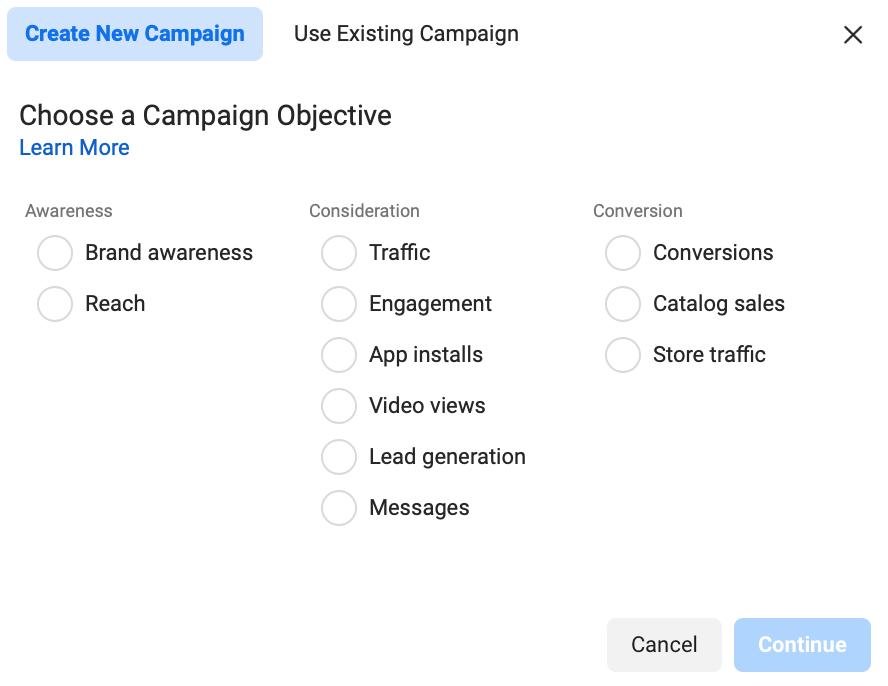
Step 3: Choose the events you want to track
Next, after you go through a screen where you can log special ad categories and choose budget optimization options, you’ll set the groundwork for your conversions campaign. The first thing you’ll do is select which conversions you want to track. You can choose from a conversion source, like your website, mobile app, Messenger or Whatsapp. Here, you can also choose the specific events to track (e.g. adding a product to cart and proceeding to checkout). Make sure that your pixel is set up to track these events. For more details on how to set this up, head to our guide to setting up and using the Facebook pixel.
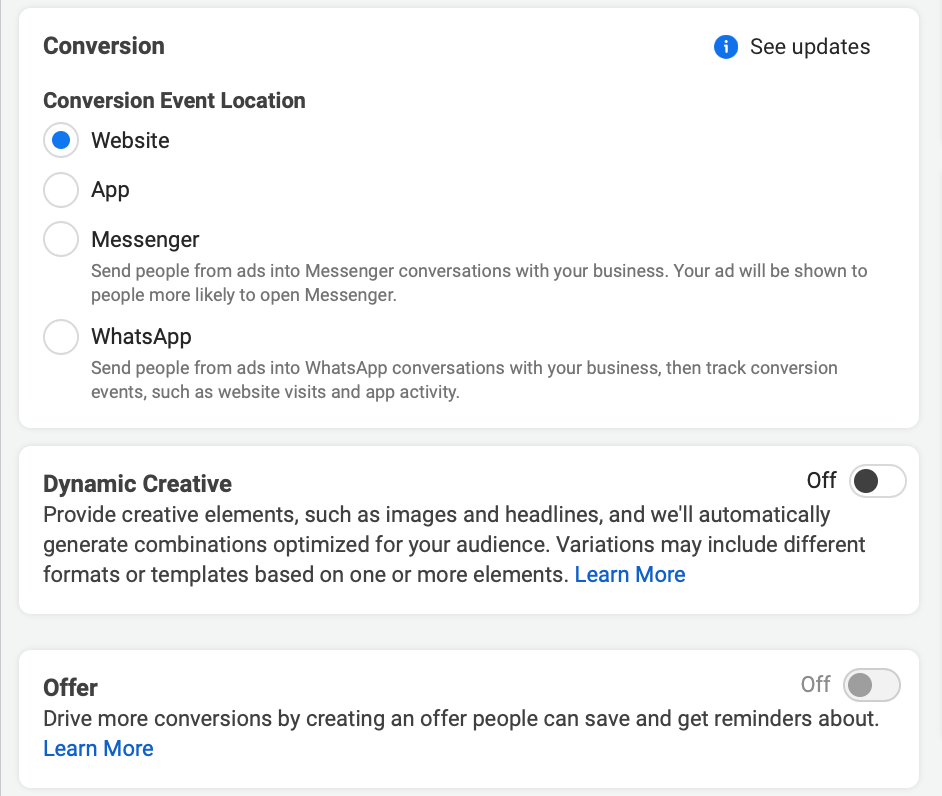
Step 4: Enable the Dynamic Creative feature
Next, enable the Dynamic Creative option, that will mix and match your images and copy to find the most effective combinations. Here, you can also add a special offer that will add value to your ad and potentially increase conversions.

Step 5: Complete the ad creation process
After these steps, you can proceed with the ad creation process as you normally would. Set your budget and your bids and get your creatives ready.
Make sure that you’re sending users directly to the right landing page where you want them to take an action — don’t just send them to your site’s homepage. If you want them to add specific products to their cart, direct them to the right product pages. And if you want them to start a free trial, show them a landing page with a demo of your software with a lead form next to it.
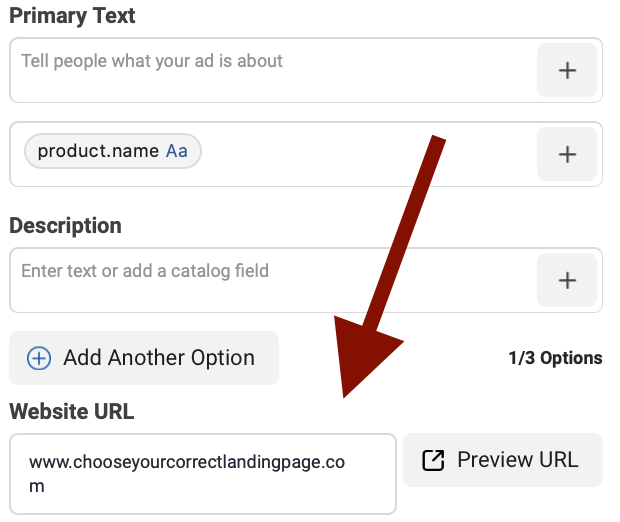
How to track Facebook ad conversions
Ready to track your Facebook ads conversion rates? There are several ways to go about it. You can use Facebook’s native dashboard or use third-party tools like AdEspresso for a more streamlined experience.
Tracking conversion rates with Facebook Ads Manager
Facebook’s native tools can give you crucial information like your conversion rate for each campaign in real-time, the exact number of conversions received and how much you paid for them on average.
To check in on your active and past campaigns, use Facebook Ads Manager. You can customize your main reporting dashboard by adding additional columns with information relevant to a specific campaign. To do this, click on Columns: Performance, and then scroll all the way down to Customize Columns…

Then, go to Conversions and Standard Events. You can add as many different metrics (along with information about total number of conversions, unique conversions, conversion value, cost and unique cost) as you need.
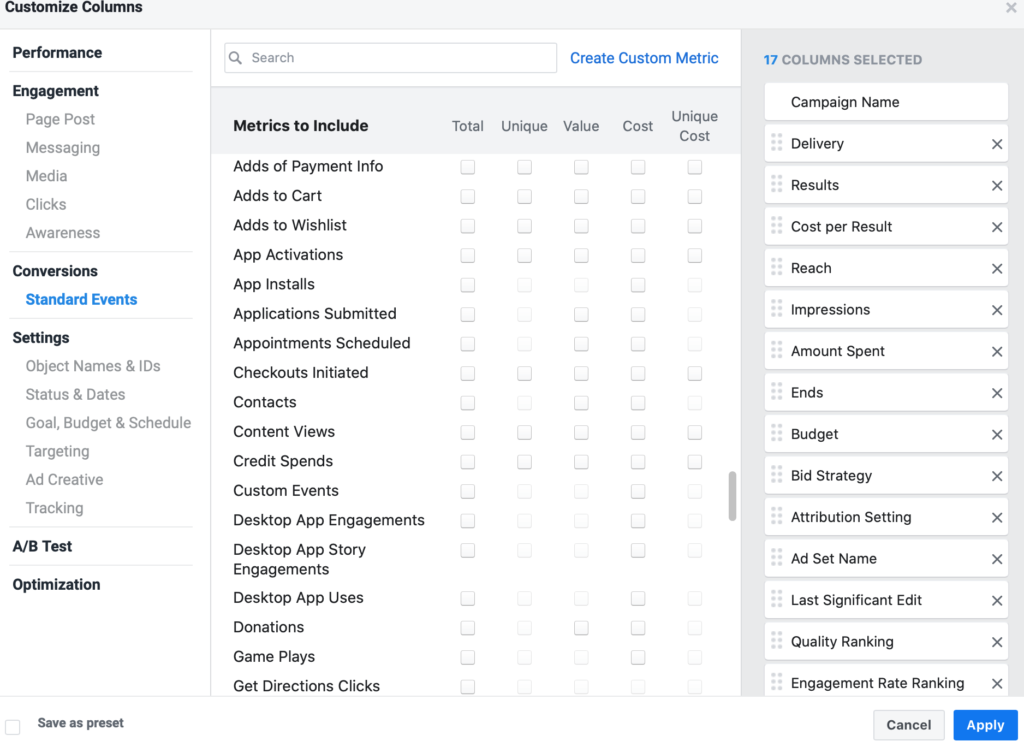
Tracking Facebook ad conversion rates with AdEspresso
AdEspresso is a Facebook Ads creation, publishing, management and analytics tool. It helps you understand everything you can about how your ads are performing, why you’re getting the results you are and how to optimize your ads accordingly.
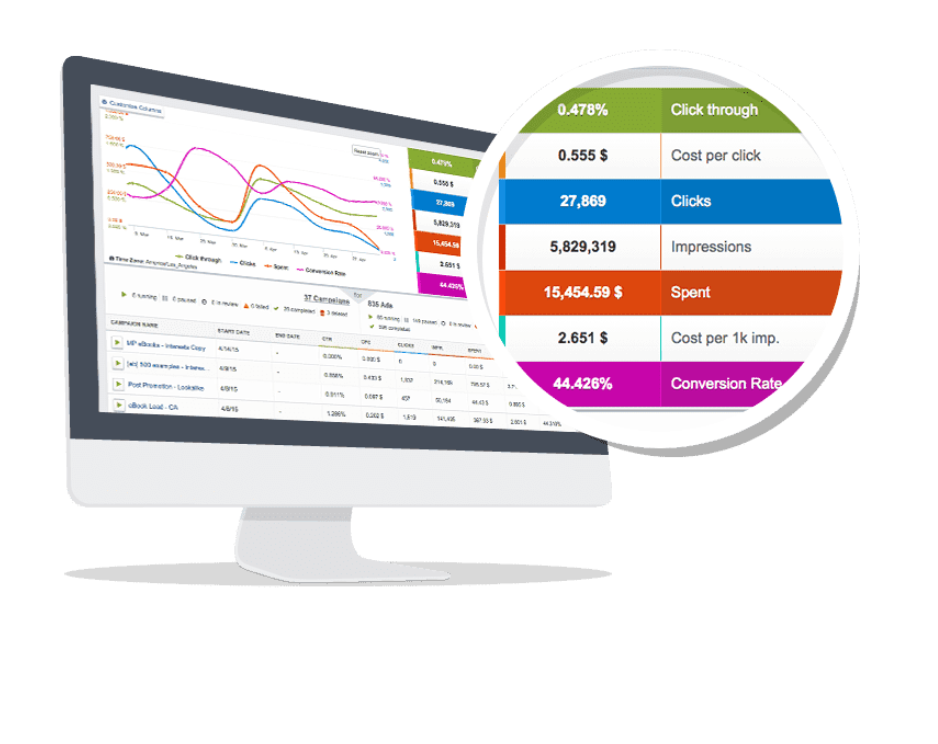
In addition to seeing exactly how many conversions each ad in each campaign has received (in real time), AdEspresso also generates personalized suggestions for how you can optimize your campaigns to drive more results at lower costs (outside of our automatic optimization features, of course). You can learn more about AdEspresso Facebook ad analytics and reporting here.
Tips for improving Facebook ad conversion rates
It almost goes without saying that everyone wants higher conversion rates on their Facebook ad campaigns, right? High conversion rates mean that campaigns are effective, and they’re driving the expected results. If you want to improve conversions from your Facebook ads, we strongly recommend you implement (or at least testing!) the five following tactics.
Tip #1: Focus on relevance
Relevance is everything when it comes to Facebook ads. It’s one of those black box metrics that directly impact how much you’re paying for each user action (CPA) and can even have an effect on your ad delivery. (It was previously called Relevance Score, but is now a factor within the Quality Ranking.) It’s essential to create ads that are as relevant to the audience you’re targeting as possible. This means you need to create different strategies for customers in different stages of the customer journey. Target new audiences with ads introducing them to the brand or product to catch their interest. Ads for your warm audience don’t have to tell your brand story on a high level. Instead, they should further user knowledge and highlight your offering’s value with immediate incentives for converting. It also means you should get familiar with the concept of user segmentation. If you’re selling a SaaS product, focus on affordability and time-saving features when addressing small businesses. For enterprise-grade clients, highlight scalability, security and easy adoption. Test different campaigns for each audience segment you target and see what’s most relevant to them.
Tip #2: Use Dynamic Ads
Are you struggling to match your product categories with the right audiences? Brands with large inventories should take advantage of Facebook’s Dynamic Ad features. Dynamic Ads allow you to pull from uploaded product inventories to show the right products to the right users at the right time. If a store like Crate and Barrel was promoting their inventory, for example, Facebook would show plates to users who had recently clicked on an ad for plates or bowls from a competitor and rugs to people watching those Ruggable videos. This saves you time while allowing you to promote your full inventory (or at least the inventory you want to showcase) to the most relevant users possible. For more information, check out our guide to Facebook Dynamic Ads.
Tip #3: Don’t cheap out
We know that marketers always feel the pressure to drive the highest return while spending the least amount of money possible. But hear us out. Sometimes quality really is worth paying for, and Facebook ads are no exception. When running campaigns, you’re fully within your right to put bid caps on each ad set to limit how much you’re spending. If you know that you’ll absolutely not be profitable paying a cent more than $3.50 per action, then you can make that your cap. But if you can afford $3.50 and still be profitable, but you’re setting your cap at $0.60 because you know that you can get some clicks at that range, you could be shooting yourself in the foot. Higher quality budgets allow Facebook to connect you with higher-value users who are much more likely to convert. And they may not just be more likely to convert now; they might be more likely to convert at higher average order values, or retain long term. Sometimes you have to spend money to make money, and while there’s nothing wrong with trying to whittle down your CPAs, make sure that it doesn’t come at the expense of results. And keep in mind that as your conversion rate goes up, your quality score on Facebook goes up, too. This means that those costs go down. Things eventually balance out.
Tip #4: Create copy that highlights value
If you want users to take a certain action, they need you to tell them exactly what to do — and why it will benefit them to do so. Of course you want me to sign up for your email list. But what will I get out of it? I don’t owe you anything. Be specific, and focus on benefits rather than features. These are a few good examples:
- “Want to win a free pair of our limited edition flats? Create a wishlist and invite friends to use it for additional entries!”
- “Subscribe to our email newsletter to get exclusive access to all the latest industry data not published anywhere else.”
- “Get more time back in your day with live chat software that keeps your team on the same page, even if they’re not on the same content. Book a demo with our team to learn more.”
5. Have extremely clear CTAs
In the examples above, you can tell exactly what action we’re trying to get users to take. Create a wishlist. Subscribe to our email list. Book a demo. These are all examples of clear CTAs. And you don’t just want to use CTA buttons — for best results, you should also include calls to action within your creatives. That way, your users won’t miss the point. They will know exactly what action you want them to take, and what will happen once they click on that link. As obvious as this sounds, it can increase conversion rates dramatically. For example, you don’t want your prospects guessing whether they’ll get a free trial or end up needing to book a demo. There is a whole segment of SaaS users who will never book a demo and only want access to a free trial to see if it’s worth it. So, if a demo is what you’re offering, be clear about it in your call to action — otherwise, you might end up getting clicks that will never convert. This can prevent you from paying for useless clicks (if that’s what you’ve chosen to bid on), but it also prevents Facebook from optimizing to show your ad to users who aren’t actually converting.
Want to streamline ad testing and optimization while improving your results? Learn more about how AdEspresso can help you here. What do you think? What tips do you use to increase your conversion rates on Facebook Ads? Share your thoughts and questions in the comments below!
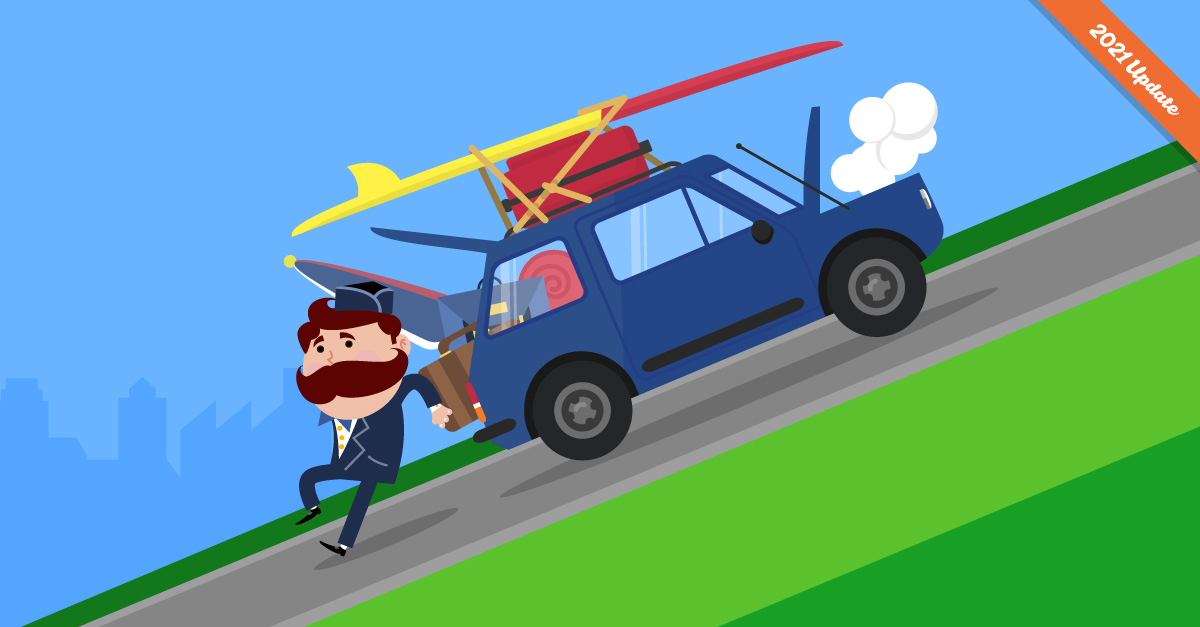

These factors are really critical to our follow-up campaigns, some people says that the frequency is one of the factors that can block accounts on Facebook, what do you think about this?
In remarketing campaigns, which frequency do you consider ideal?
Overall I like to keep my frequency below 5/6 as above that, performances decrease quickly. However it really depends on your business. If you have high margins and a product which people only need once in a while (ie: loans) it makes sense to let the frequency go higher
Question for you. How do you keep your frequency score low?
I find that ad copy and image selection make a big difference in the CTR. Using tons of A/B tests will eventually create better and better results.
Found this extremely useful. Thanks for writing this up. Does targeting a very specific and a small group increase the cost? coz we know for sure that they are the target audience and are more likely to get engaged with the advert. In my case, I want to target the employees of few specific companies in a specific geographic location. Thanks.
It depends on the specific audience; if that specific audience is in high demand, it can raise the cost. Still, if you know they’re more likely to convert, it can be worth the raised cost. There are so many factors involved that, unfortunately, there’s not really a one size fits all.
I’m running 2 accounts and recently we saw that any campaign launched after 7/29/2016 had a huge increase in CPC cost.
For example we saw an increase from $0.26 per click to $10 per click on similar audience and campaigns. Has anyone else seen this?
I have noticed that our CPC is about twice what was considered typical in Q1 and Q2 for our target audience (AdEspresso Q1 and Q2 data). I think it may be due to pre-holiday ads that are driving up prices in advance of black friday.
We have seen our cpm costs triple and quadruple since the summer of 2016 for exactly the same audiences and ads. These prices have gotten even higher after Christmas in January 2017. This even applies to ads with relevance scores of 9 and 10.
These are all in the German market. I have tried to see if this is something across the board with FB just raising its prices massively but so far have found no reliable information about this.
Hey There! I live and die by doing targeted ads revolving around event responses. Is the wild cost swings in the “engagement” option, for the same reasons as the ones you detailed. I have two targeted matching ads in two similar DMAs, and one is $8/event response, and the other is $1.78/event response.
I’m interested in trying Facebook ads but will give it a go after Bing Ads because it sounds expensive
I have just started fb ads for my clients and this article really helped me very much in ads conversion. Thank you for sharing this great informative content.